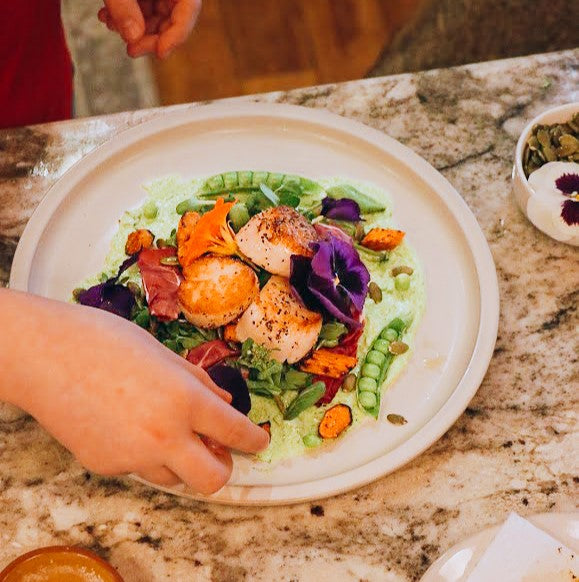We’re here to help you purchase and cook the best shrimp possible. But we know there can be some challenges with knowing the best ways to purchase shrimp, thaw it, and cook it.
That’s why we created The Short Guide on How To Cook Shrimp!

In this guide you’ll find everything you need to know so you can buy the best quality shrimp, food safety tips to follow, plus cooking techniques. All you’ll need are great shrimp recipes to pick from! (We’ve got you covered there as well. Go here and here for several incredible shrimp recipes).
Table of Contents:
- Where to Buy the Best Shrimp
- Two Methods for Thawing Frozen Shrimp
- Understanding Shrimp Sizes
- How to Peel, Devein and Clean Shrimp
- How Do I Know When Shrimp is Done Cooking?
- How to Grill Shrimp
- How to Cook Shrimp on The Stove
- How to Cook Shrimp In The Oven
- Keep Your Shrimp Wild, Sustainable...and Flash Frozen
Where to Buy the Best Shrimp
Tip: Buy once-frozen seafood online when you can’t get your seafood fresh at the dock.
As longtime customers and readers know, at Wild for Salmon we recommend buying once-frozen seafood online when you can’t get your seafood right off the dock.
While we appreciate our local food systems - when it comes to seafood, we believe folks are better off buying frozen seafood online rather than thawed, mislabeled “fresh” seafood, from the local counter.
Buying from trusted online retailers like us and our partners means you are getting shrimp and seafood that is frozen - just once - soon after being caught.
Therefore, the freshest-tasting shrimp is the kind you buy frozen online.
Shrimp that is on ice in grocery stores and markets were usually previously frozen, then put on ice to thaw, and who knows how long they've been thawed!
The safest and most delicious way of cooking shrimp is starting with once-frozen shrimp and thawing it the day of preparation. Our Wild Alaskan White Gulf Shrimp is frozen when it is caught, remains frozen during shipping to us, storage, and shipping to you.
Thawing Frozen Shrimp
So, how do you maximize taste when cooking Wild Gulf Shrimp once it arrives on your doorstep? By thawing it with one of these two methods - slow thaw or just before cooking.

One option is to slowly thaw the frozen seafood in the fridge. Plan for about 24 hours of thawing for each pound.
The second method is the one we use most often: thawing the product right before cooking, which we recommend not only for safety but also convenience (we are busy, just like you!).
To thaw shrimp before cooking, take the shrimp out of its package and put it in a bowl or a colander in the sink. Then run cold water over the shrimp for about five minutes. Toss the shrimp occasionally to make sure they are all exposed to the cold water. You will know that the shrimp is ready when they are no longer frozen solid but soft, easily bendable, and slightly translucent. This will only take a few minutes and only a small stream of water - waste not, want not!
Before cooking, no matter the method, pat your shrimp dry with a paper towel or clean cloth.
Safety Tip: Never thaw shrimp by letting them sit at room temperature for an extended period of time!
Understanding the Sizing of Wild Shrimp
If you’ve been thinking about cooking shrimp, you might have noticed that there are a lot of different sizes of these wonderful bursts of flavor!
The common sizes - small, medium, large, extra-large, jumbo, and colossal - are vague. Because it’s hard to know exactly what you're getting in those cases. At Wild for Salmon we have a better method - we rely on “count numbers” as a more accurate way of understanding what you’re ordering when you buy shrimp online from us.
16/20 per pound – are bigger. In each pound bag, you’ll get between 16 and 20 shrimp. Looking for some big shrimp? Try our Wild Caught Brown Gulf Shrimp.
26/30 per pound – are smaller. In each pound bag, you’ll get between 26 and 30 shrimp. These Wild Caught Brown Gulf Shrimp are the same species as the above, just smaller.
250/300 per pound – are very small. In each pound bag, you’ll get between 250 and 300 shrimp. In our online seafood store, these are our Wild Caught Pacific Northwest Salad Shrimp.
To compare these shrimp counts to other names of shrimp sizes, here’s a helpful reference chart.
|
Colossal |
Fewer than 15 shrimp per pound |
|
Extra-Jumbo |
16-20 per pound |
|
Jumbo |
21-25 per pound |
|
Extra-Large |
26-30 per pound |
|
Large |
31-35 per pound |
|
Medium |
41-50 per pound |
|
Small |
51-60 per pound |
|
Extra-small |
61-70 per pound |
How to Peel, Devein and Clean Shrimp
Depending on your recipe, you can cook shrimp with the shell on or off.
If you want to peel off the shell, start by pulling off the legs of the thawed shrimp, and the shell will easily slip off. You can leave the tail part of the shell on or remove it by pinching and pulling it off. For cocktail shrimp, many people leave the tail on the shrimp as a handle to hold on to.
Shrimp have a dark threadlike digestive tract, popularly known as the vein. You can see this gray line where it runs along the top to the bottom of the shrimp’s back. Most folks prefer to remove the vein before cooking shrimp, otherwise you could get a slightly sandy texture in your meal.
If you want to keep the shell on, you can use kitchen scissors or a small sharp knife to cut through the thawed shrimp shell along the back, from the head to the tail. Use the tip of the scissors or knife to lift out the vein. If the shell has been removed already, just cut a slit along the back and remove the vein
In either case, if there is any of the vein left, rinse with cold water to remove the last of it.
How Do I Know When Shrimp is Done Cooking?
An important trick to cooking shrimp is learning how long to cook it. Like a lot of seafood, shrimp cook very quickly. It only takes a few minutes for even the largest shrimp to start turning pinkish and curling up. Keep a close eye on them to avoid overcooking!

Thankfully, it’s easy to know exactly when shrimp are done. You’ll know when shrimp are done cooking because they’ll have turned from translucent, grey and soft to completely opaque with a pink color, bright-red tails, and a firmer texture.
To summarize, overcooked shrimp will tightly curl into an “O” shape and be dark pink in color. Undercooked shrimp look like a wide and flexible “U” shape and may remain translucent. Perfectly cooked shrimp are pink with bright red tails and “C” shaped.
Tip: Make sure to start cooking with thawed shrimp (not frozen). Using frozen shrimp can create an undesirable rubbery texture.
How to Grill Shrimp
One of the most popular (and for good reason!) ways to cook shrimp is as kebabs on the grill. After peeling, deveining and marinating your shrimp, follow these instructions for cooking shrimp on the grill.
Direct Grilling:
Grill shrimp at a medium temperature, with the grill shut, until opaque:
Indirect Grilling:
You’ll want to keep them on the heat for a bit longer.
Rotate the kebabs once. When grilling shrimp, always check for a pink color on the outside. Cut into a skewered shrimp to make sure the flesh is opaque throughout. We do not recommend grilling smaller size shrimp because of how easy it is to overcook them with this method.
How to Cook Shrimp on the Stove
You can boil your shrimp or cook it in a skillet, depending on your recipe and it will deliver a delicious result.
A good ratio for boiling shrimp is one pound to four cups of water, so:
Cooking shrimp on a stove-top skillet is also quick. To cook in a skillet:
How to Cook Shrimp in the Oven
Cooking shrimp in the oven makes for easy clean-up and delicious shrimp. To cook shrimp in the oven, you’ll need aluminum foil and some high-heat.
Keep Your Shrimp Wild, Sustainable...and Flash Frozen
As always, at Wild for Salmon, if we aren’t catching the product ourselves, we partner with trusted fishermen who care about sustainability and quality.
To offer shrimp that is delicious, sustainable, of high-quality and available to sell online, we offer both Brown and White Gulf Shrimp from Louisiana and Salad Shrimp from the Pacific Northwest.
Although shrimp is farmed and harvested all over the world, we believe in offering a domestic product in order to reduce food miles and to know our fishermen as much as possible.
Author of American Catch, Paul Greenberg offers a strong warning against internationally farmed shrimp in his book, as described in this 2014 NPR interview. Farmed shrimp is fed fish meal made of wild fish. It’s an unsustainable practice. The wild fish are removed from the ocean in order to grow a farmed product.
A better approach is to work with a naturally-supported ecosystem as is the case with the wild shrimp from the Gulf of Mexico and off the coast of America’s Pacific Northwest. We trust our shrimp fishermen to follow regulations, just as we do in Alaska, in order to make sure the catch is not overfished.
As believers in wild fish, we are also supporters of natural foods. The ocean food chain leads to a better and more tasty product than shrimp living off fish-meal and other antibiotic-filled food.
Finally, the quality of the shrimp is of utmost importance to us because we want it to arrive at your doorstep ready to thaw and enjoy via one of the easy and delicious methods of cooking shrimp listed above. The once-frozen, flash-frozen technique maintains freshness and flavor, as our friend and chef Emma Frisch elaborates on in this blog - which includes a recipe for Cajun Shrimp and Wild Rice!

 Wild Alaska Salmon
Wild Alaska Salmon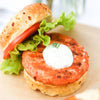 Alaska Salmon Burgers
Alaska Salmon Burgers Smoked Salmon & Seafood
Smoked Salmon & Seafood Wild Alaska Whitefish
Wild Alaska Whitefish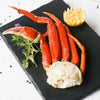 Wild Shellfish & Shrimp
Wild Shellfish & Shrimp Wild Albacore Tuna
Wild Albacore Tuna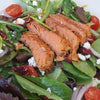 Canned Seafood
Canned Seafood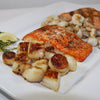 Meal Box & Samplers
Meal Box & Samplers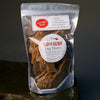 Pet Products
Pet Products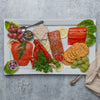 Gifts
Gifts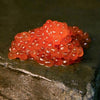 Specialty
Specialty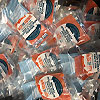 Wholesale Ordering
Wholesale Ordering